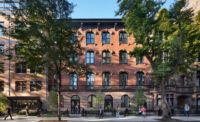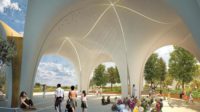San Antonio, Texas
Silence and humility figure prominently in the Quaker way of life. That’s why Ted Flato, FAIA, and Bob Harris, AIA, of Lake/Flato Architects, used both principles to guide the design for the 4,800-square-foot Friends Meetinghouse in San Antonio, Texas. The architects responded to the challenge of achieving silence on a site bordered by busy roads and an apartment complex by tucking the L-shaped building into the gently sloped site with the main gathering hall located at the back, where native plants grow in a drainage area. This offered a secluded garden setting suitable for contemplation.
Arriving parishioners approach the small complex on a path that meanders through xeriscaped shrubs and mature mesquite and acacia trees, which block a nearby beauty salon from view. As one treads the circuitous path, the gradual arrival sequence allows the mind to settle, shedding the busyness of daily life until one passes through a heavy wood-slotted gate set in a thick limestone perimeter wall. Harris describes the material of the wall as “old yella,” a term he uses for the off-white, locally quarried stone used in many buildings in town. The stone lends an air of permanence to the premises, while also calling to mind the nearby Alamo, which is surrounded by a similar enclosure. Once inside, parishioners encounter a covered portico stretching along a wing housing a series of small rooms, including a nursery and a library. With a garden courtyard on the right, circulation continues to the main meeting space on the other side of the building’s “L” plan. Each parishioner’s journey of quietude ends in the main hall, where Friends gather to practice attentive silence.
Lake/Flato realized humility in its design by embracing a domestic scale, simple symmetry of forms, and unadorned, inexpensive materials, taking cues from traditional American Quaker meeting houses shaped by similar design conditions. The architects clad the exterior of the 1,024-square-foot main gathering hall in horizontal panels spaced about 1 inch apart and made of an extremely durable, low-maintenance cementitious material derived from recycled paper—a modern, sustainable interpretation of vernacular meeting-house design. A gambrel roof, with exposed interior wood roof trusses, creates a barnlike effect inside. Interior walls and ceiling are finished in cedar slats spaced the same as the exterior panels, but with acoustical sound barriers made of Homasote, a 100 percent recycled material, behind them.
Harris comments, “In the meeting space itself, one can silently sense a warbler bounce between branches, the movement of translucent leaves, and shifting of light around you.” The architects achieved this sense of openness and lightness with some subtle architectural cues. Clerestory windows top the gabled entry wall on the west. Beneath the deep-hanging roof eaves, the south and north walls feature high windows, allowing daylight and breezes to ventilate the space, but offering no views. The windows pay tribute to the Friends’ belief that worshipers ought not to be distracted by the activities of the world outside.
PeopleArchitect: Ted Flato, AIA Engineer(s): Civil Consultant(s): General contractor: Photographer:
|
ProductsExterior cladding EIFS, ACM, or other: Roofing Windows Glazing Doors Hardware: |



Post a comment to this article
Report Abusive Comment